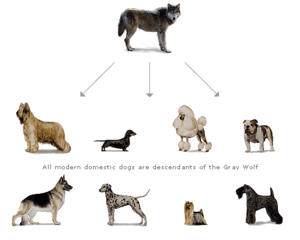Evolution of Dog Breeds
Introduction
The evolution of dog breeds is an interesting story of human involvement in the domestication of a wild animal. The domestic dog is called Canis familiaris The artificial selection of dog breeds has led to diversity in size, conformation, and pelage seen today in domestic canines[1]. The dog evolved approximately 12,000-15,000 years ago when early humans domesticated animals and plants for farming during the Stone Age. There are different views on how dogs evolved- was their evolution due to humans selecting animals for domestication, or that the animals had to evolve because they were in a new ecological niche (co-existing with humans in a domestic setting) [2]? Through phylogenetic analysis of dog and gray wolf mitochondrial DNA (mtDNA) sequences, it was found that domestic dog sequences are found in at least four distinct clades, implying a single origination event and at least three other origination or interbreeding events [3].
[4].
Genetics
Include some current research, with at least one image.
Microbiome
Include some current research, with a second image.
Conclusion
Overall text length should be at least 1,000 words (before counting references), with at least 2 images. Include at least 5 references under Reference section.
References
Edited by Tillie Wang, student of Joan Slonczewski for BIOL 116 Information in Living Systems, 2019, Kenyon College.

